This post may contain affiliate links at no additional cost to you. As an Amazon Associate I earn from qualifying purchases. Click to view our full disclosure.
What's inside
Have you been considering mixing up your training with an upper lower split workout?
You may currently be a beginner performing your full body workouts, or an advanced lifter hitting your weekly bro split. But is there a more effective way to maximize your gains?
Changing to a split routine is one of the most common questions I have received over the past 13 years as a trainer.
Today, let’s discuss how to maximize your gains with the upper/lower split workout.
Keep reading as I cover the benefits, things to consider, and professional tips to help you train at your peak and get incredible results.
Let’s dive in.
What are the different workout splits?
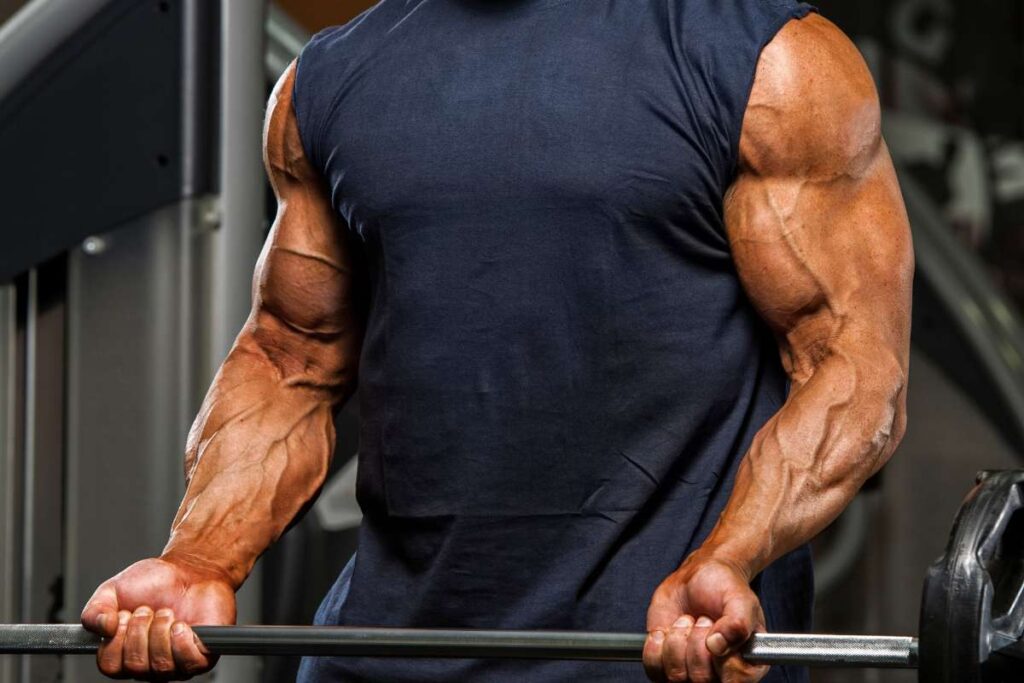
There are a few different workout splits that can be used to increase strength, build mass, and improve performance.
Here’s an overview.
Upper/Lower Split
The upper/lower body split allows you to break up your training into upper body and lower body components.
The upper/lower split gives you the ability to hit the gym on back-to-back days, with one half of the body working while the other rests and recovers.
This makes it a great option for beginners who are transitioning from full-body workouts to split routines.
It’s also excellent for advanced lifters who want to increase their training volume, helping them hit the upper and lower body muscles twice per week.
Bro Split
Bro split refers to the standard bodybuilding split of chest, back, legs, shoulders and arms, with the objective of dedicating large amounts of sets and reps to each muscle group.
This can be a great way to hone in on specific muscles and stimulate growth. However, if you want to build for strength or improve function, other splits such as push/pull/legs will likely be a better fit.
Push/Pull/Legs (PPL) Split
The push, pull, and legs split is one of the most effective splits for building muscle and improving function.
With the PPL, you’re building training days around your movements. You will program movements that require full-body pushing and pulling while getting a good leg session in at the end to build strength.
What is the upper/lower split workout?
The upper lower split workout is for anyone who wants to increase their training volume for their upper and lower body.
This type of split is great for progressing from a full-body workout. It’s also worth trying for anyone who wants to work out on back-to-back days without impairing recovery.
One of the great benefits here is that you can easily hit both upper and lower body workouts in a three, four, or five-day weekly split program.
This means that you can increase the number of overall sets and reps that you are hitting with your upper and lower body with each week, enhancing muscle hypertrophy.
Things To Consider When Deciding on the Upper Lower Split Workout
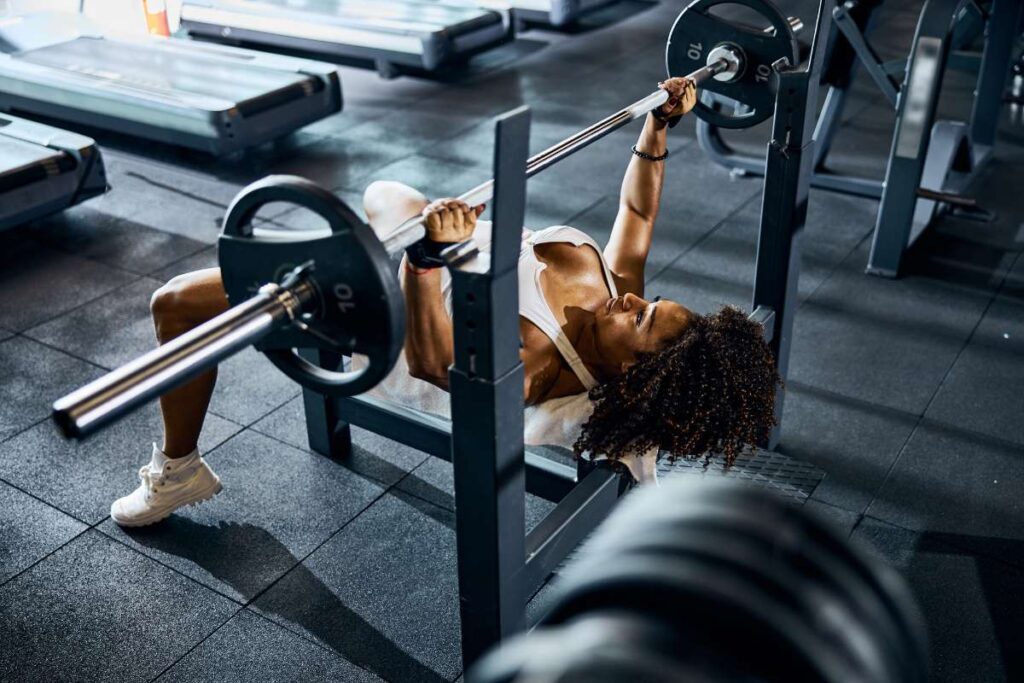
On paper, an upper/lower split seems like a great idea for anyone wanting to increase the volume of their training.
However, you need to be clear and realistic about your goals, schedule, and experience level.
Experience Level
One of the first things to consider is your current level of experience in the gym and with resistance training.
The upper/lower body split may not be particularly strenuous at beginner levels. That said, it may come as a shock to some who jump the gun and dive head-first into heavy training days back-to-back.
Our recommendation here is to start with a three-day upper lower split workout that allows you to program a rest day between training days.
By doing this, you’ll replenish your energy stores and let your muscle recover before your next big session.
Training Goals
Having clearly defined goals when it comes to your training is a must, and the upper lower workout routine is no different.
Goals help you program accordingly, selecting the correct exercise to get the job done.
Let’s say you are looking to build lower-body strength with a back squat consisting of heavy weight and low reps.
Or, you want to broaden and define your back with deadlifts and chin-ups. All these things should be considered while programming your training block.
Availability
Too often, we get excited by the prospect of achieving massive gains with the program to end all programs. Yet, things fall apart when it doesn’t fit into our schedule.
That one skipped session gradually becomes a habit. Before you know it, we’re dropping the program altogether.
That’s why we create a training schedule that fits with our current availability. Instead of changing your whole schedule to accommodate a ton of new training, work with what you already have on your plate.
When we do this, we give ourselves the best chance of hitting each workout, allowing us to consistently build toward achieving our goals.
Sessions Per Week
The upper lower workout split is a versatile style of programming that gives you the flexibility to train three, four, five, or even six days per week – depending on your schedule and experience level.
While the programming for your upper and lower body workouts will remain the same, the ability to change their configuration throughout the week makes it a great split.
Your job here is to consider how many days will help you perform, without overtraining. As we recommended earlier, beginners should start with three sessions per week.
From here, you can get a feel for the routine and increase the number of sessions as you progress.
Rest Days
Scheduling rest days is essential to not only your lifts, but your growth.
Studies suggest that you need 48-72 hours between workouts to repair damaged muscle tissue and replenish muscle energy stores.
Often, when we finally branch out into split training, we can get a little excited and want to hit the gym a few more days each week.
While this may feel great at the beginning, it can lead us to feeling tired and overtrained in the long run.
To avoid this, maintain consistency, and continue toward our goals, stick to a more realistic split.
Leave at least two days for rest both physically and mentally, allowing your body to recharge for another big week ahead.
Main Benefits of Upper Lower Split Workout

You have likely heard that performing an upper lower split workout is a great way to train in the gym. But what are the specific reasons many choose this type of training?
The following benefits of using an upper lower body split can help you decide if this is truly the right split for you.
Great for Beginners
The upper and lower workout split is great for beginners because it introduces the concept of training opposing muscle groups on separate days.
It is especially beneficial for those who are making their jump from the full-body workout. It allows them to hone in on specific sections of the body and increase the number of exercises and working sets for each body part.
Increases Training Volume
Training your muscles using an upper/lower workout split is a great way to target the same muscle groups multiple times per week.
Research indicates that this increase in volume can enhance muscle hypertrophy.
This makes the split great for anyone who wants to develop certain aspects of their body and see additional growth.
Time-Efficient
One great thing about a split routine is that you can increase the number of sets per muscle group while still decreasing time in the gym.
Typically, when we hit a full-body workout, our session can seem to go on forever as we attempt to hit each muscle group.
This is how we end up hitting the major movements and missing the smaller ones.
Upper/lower splits, on the other hand, are time efficient. You split the workout in two parts, giving you room to plug in additional exercise while maintaining a shorter duration.
The results? More time on each muscle group, less time in the gym, and better gains.
Flexible Programming
The upper and lower body split workout offers a level of flexibility that is great for any experience level and schedule.
For beginners, a three-day upper/lower split adds the challenge of more exercise per muscle group, while still providing four rest days per week.
Meanwhile, advanced lifters can perform the four or even five-day upper split to pack on mass.
This means that whatever your availability, you will be able to fit in your workouts each week. The added bonus is still having time to fit in extra sessions when you want to progress.
Improves Physique
As you increase your training volume and stimulate greater muscle growth, you will begin to notice a difference in your overall build.
The upper/lower split gives you the more time to target those lats for a wider back, delts for those boulder shoulders, and a lower body day dedicated to building thick, muscular legs.
This all contributes to sculpting that lean and muscular physique.
Drawbacks of Upper Lower Split Workout
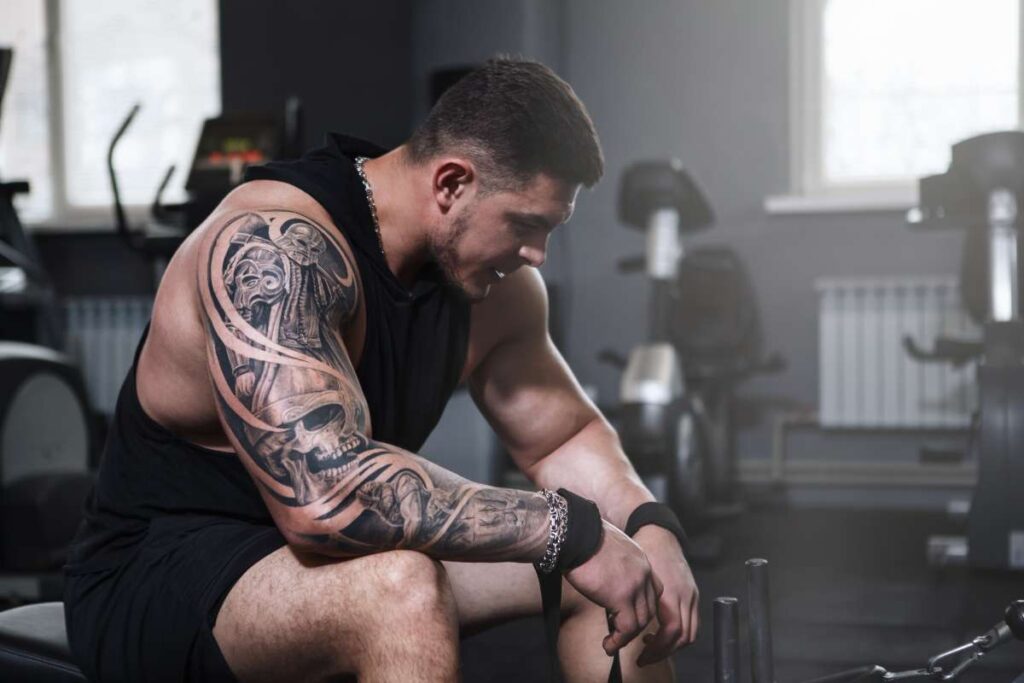
So, now that we have covered the benefits, let’s talk about some of the drawbacks of this style of training.
Not Optimal for Certain Goals
The upper/lower split routine does provide an excellent balance, but it may not suit everyone’s goals.
While you do get additional time to hit those upper and lower body muscles, many want to spend more time on groups such as the chest, back, shoulders, and arms.
That may require a bro split, increasing the specificity of their lifts.
Alternatively, many advanced lifters use the push, pull, and legs split, as it is a three-day minimum split routine that is great for building strength.
Repetitive
The upper/lower split can feel a little more repetitive compared to other split routines.
When we program a bro split or PPL split, there are three to five different workouts through the week.
An upper/lower split, on the other hand, is the same two sessions. Some may find it monotonous.
Potential for Overtraining
One of the incredible benefits of this split is that you can train back-to-back days at any time of the week.
However, this can also be one of its major drawbacks, as there’s the potential of overtraining.
Studies indicate that when we overtrain we may experience greater soreness and fatigue. Our lifts may suffer due to muscle damage and a decrease in stored energy.
When we train with limited rest and recovery days, our body can begin to give out physically and mentally.
The key here is to program your rest days to ensure your body has time to recover and grow.
Tiring
Performing an upper/lower split can be extremely tiring for both beginner and advanced lifters.
The introduction of a second leg session each week with only one session in between can prove to be difficult, especially if your programming is lengthy or strenuous.
The solution here again is to ensure you have programmed a rest day to allow your body and mind to recover. This will help you stick with it for the long haul.
Best Exercises for the Upper Lower Split Workout
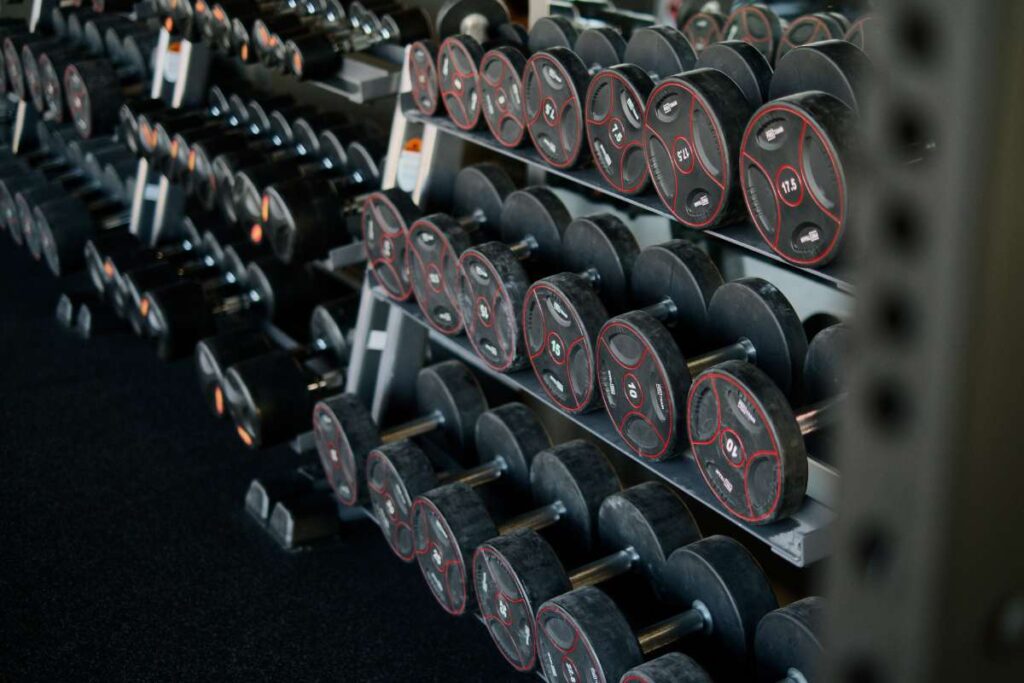
It’s all well and good to train your upper and lower body in a split routine, but without the correct exercises, you will be leaving a lot on the table in terms of strength and muscle growth.
Below we have listed the eight best upper and eight best lower body exercises to help you build an effective split.
8 Best Upper Body Exercises

1. Bench Press
If you are building your upper body, the bench press should be at the top of your list for increasing mass and strength.
Targeting the chest, shoulders, and triceps, the bench press is an excellent compound lift to begin your upper body workouts.
Equipment Requirements
- Bench Press
- Barbell
- Weight Plates
How To Perform the Bench Press
- Sit down on the bench press and lie back.
- Position yourself so that the barbell is directly over your eye line.
- Grab the barbell with hands just wider than shoulder-width apart.
- Push the barbell up to unrack and bring it directly over your chest.
- Begin by bending your elbows and lowering the barbell down toward your chest.
- Lower until your elbows are bent at 90 degrees.
- Push up to the starting position. Repeat.
Benefits
- Targets chest, shoulders, triceps
- Increases muscle Mass and strength
Pro Tips
- When setting up, ensure that your feet are firmly planted on the floor. This will improve stability and your capacity to lift the barbell.
- Focus on breathing, inhaling as you lower and exhaling as you press.
2. Incline Dumbbell Press
The dumbbell incline press is a great exercise for targeting the upper chest while the use of dumbbells require each arm to lift independently.
This helps you build a fuller chest and sculpt your physique.
Equipment Requirements
- Dumbbells
- Incline Bench
How To Perform the Incline Dumbbell Press
- Holding a pair of dumbbells, sit down on the end of a bench.
- Lie back on the bench and push the dumbbells directly up into the air.
- Begin by bending your elbows outward and lowering the dumbbells toward your chest.
- Lower until your elbows are bent at 90 degrees, then push back up until arms are straight. Repeat.
Benefits
- Builds fuller chest
- Builds strong physique
Pro Tips
- When performing the incline press, press directly up. This will target the upper chest.
- Beginners should start with a lighter weight to familiarize themselves with the range of motion, then increase when they are comfortable.
3. Dumbbell Overhead Press
The dumbbell overhead press targets the shoulders. It’s great for further increasing your upper body mass while improving your overhead strength.
Equipment Requirements
- Dumbbells
- Bench
How To Perform the Dumbbell Overhead Press
- Hold a pair of dumbbells in each hand on the bench.
- Press the dumbbells up overhead so that your arms are straight.
- Start the movement by unhinging the elbows and lowering the dumbbells out to the sides.
- Lower until your elbows are bent at 90 degrees, then press back up to the starting position. Repeat.
Benefits
- Builds bigger shoulders
- Improve overhead strength
Pro Tips
- Keep shoulder blades slightly back and chest proud for the duration of the movement. This allows for greater shoulder range of motion.
- If you are struggling to press overhead, bring your elbows into a 45 degree angle. This will reduce pressure on the shoulder and allow for a smoother overhead press.
4. Pull-Ups
The pull-up is considered one of the most effective exercises for building the back and biceps. Being a bodyweight exercise, you can do it almost anywhere there’s a bar.
Equipment Requirements
- Pull-Up Bar
How To Perform Pull-Ups
- Standing below the pull-up bar, reach overhead and grab the bar with an overhand grip.
- Begin by pulling shoulder blades back and down.
- Pull yourself up toward the bar until it meets your collarbone.
- Lower back to the starting position and repeat.
Benefits
Pro Tips
- Tense the body and keep legs straight for the duration of the movement. This will minimize unwanted movement and improve your ability to pull yourself up.
- When pulling up, focus on pulling shoulder blades back and down toward the floor. This will help you engage the muscle of the back.
5. Dips
Dips are an incredible exercise for targeting the chest, shoulders, and triceps, giving you the ability to pack on serious muscle and increase upper body strength.
Equipment Requirements
- Dip Bars/Bench
How To Perform Dips
- Standing between the dip bars, grab one in each hand.
- Jump and hoist yourself up so that your arms are straight.
- Start by bending your elbows and lowering yourself toward the floor.
- Lower until your elbows are bent at 90 degrees.
- Then, push yourself back up to the starting position. Repeat.
Benefits
- Build upper body strength
- Builds lean muscle
Pro Tips
- If you are finding it difficult to hoist yourself up, use a step to get yourself into the starting position.
- When performing the dip, gradually lower while keeping your elbows to the sides. This will help isolate the triceps.
6. Lat Pulldown
The lat pulldown is designed to target the back and biceps. The movement mimics a pull-up without the need to lift your own body weight.
This is great for beginners who want to get those incredible physique altering benefits.
Equipment Requirements
- Lat Pulldown
How To Perform the Lat Pulldown
- Sit down on the lat pulldown and position knees under the pad.
- Reach overhead and grab the bar with an overhand grip just wider than shoulder-width apart.
- Begin by engaging shoulder blades back and down.
- Pull the bar down to your collarbone.
- Release the bar back up to the starting position slowly and with control. Repeat.
Benefits
- Targets back and biceps
- Improve physique
Pro Tips
- Lean back slightly to allow the bar to pass the chin and go down to the collarbone.
- When pulling down, focus on squeezing the elbows down toward the floor. This will improve contraction of your target back muscles.
7. Cable Row
The cable row is an excellent exercise for targeting the back, giving you the perfect angle to build a broad, muscular lats.
Equipment Requirements
- Cable Row
How To Perform the Cable Row
- Sit down on the cable row and place your feet on the platform in front of you.
- Reach forward and grab the handle, then push yourself back so your torso is upright and knees are slightly bent.
- Begin by retracting shoulder blades and rowing the handle toward your body.
- Row until your elbows are bent at 90 degrees, then release back to the starting position. Repeat.
Benefits
- Builds broad, muscular back
- Improves overall physique
Pro Tips
- Retract the shoulder blades prior to each rep. This will draw focus to your target muscles and increase contraction for each rep.
- Focus on breathing, exhaling as you pull and exhaling as you release.
8. Barbell Bicep Curls
The barbell bicep curl is a simple and effective movement that is perfect for rounding out your upper body workout.
Adding this to your session will help carve out strong, muscular arms to give you that athletic-looking build.
Equipment Requirements
- Barbell
How To Perform Barbell Bicep Curls
- Stand holding a barbell in an underhand grip with arms extended.
- Start by curling the barbell up toward the shoulders until your elbow reaches full flexion.
- Then, lower the barbell down until your arms are completely extended. Repeat.
Benefits
- Builds upper body mass
- Improves physique
Pro Tips
- When setting up, place feet shoulder-width apart, knees slightly bent, and brace the core. This will improve stability and your ability to contract your biceps.
- When performing the curl, focus on squeezing the belly of the bicep with each rep. This will improve mind-muscle connection and results.
8 Best Lower Body Exercises
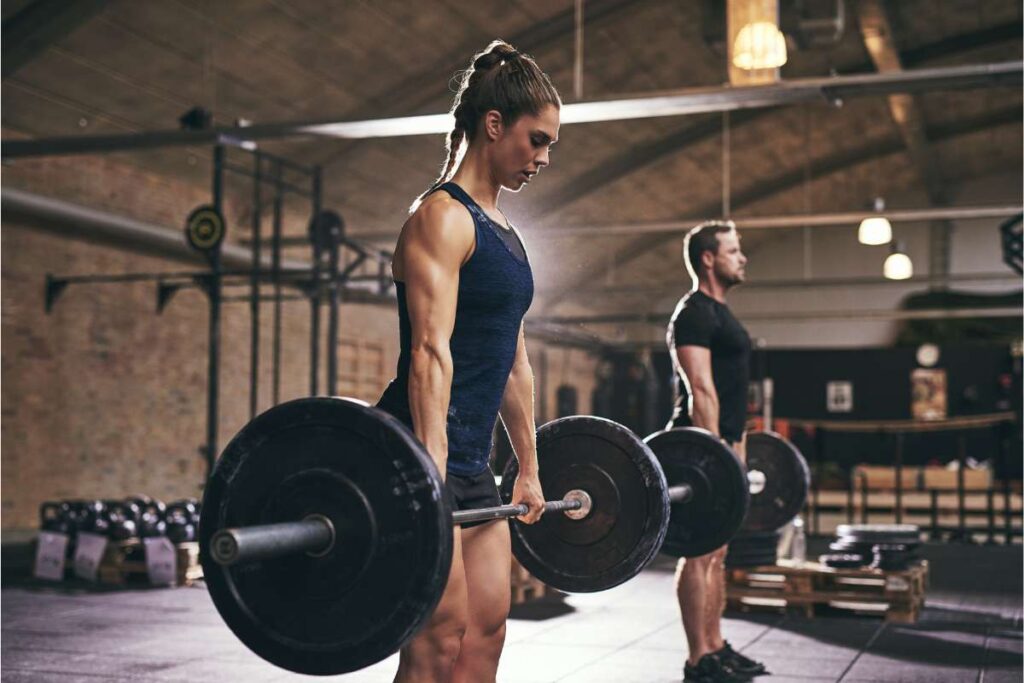
1. Back Squat
The back squat is considered the king of all lower-body lifts, placing it at the very top of our lower body exercises list. It’s excellent for building lean mass and strength.
Equipment Requirements
- Barbell
- Squat Rack
- Weight Plates
How To Perform the Back Squat
- Standing in front of the squat rack, step under the barbell and position it on the belly of your upper trap.
- Push up with your legs to unrack the barbell and take two steps back, away from the rack.
- Begin by unhinging your hips and lowering yourself down toward the floor.
- Lower until your knees are bent at 90 degrees, then push back to the upright position. Repeat.
Benefits
Pro Tips
- When positioning the barbell on your back, grasp the barbell and keep shoulder blades back and down. This will secure the barbell and keep the upper body rigid for the lift.
- Prior to each rep, inhale and tense your core. This will make the torso rigid and improve your capacity to lift.
2. Deadlift
The deadlift is an amazing exercise for targeting the entire body, allowing you to build the legs, glutes, and back in one awesome movement.
This makes it a great addition for both upper and lower body workouts.
Equipment Requirements
- Barbell
- Weight Plates
How To Perform a Deadlift
- Stand with a barbell set up on the floor in front of you.
- Position the barbell directly over the top of your shoelaces.
- Unhinge your hips and lean forward to grab the barbell just wider than hip-width apart.
- Drop your hips slightly, and gently pull shoulder blades down toward your hips to activate your lats.
- Begin by pushing up through your legs until the bar passes your knees.
- Then, push forward with your hips until you reach the upright position.
- Once at the top, unhinge at the hips, leaning forward and lowering the barbell.
- Once it passes your knees, bend your knees and lower it to the floor with control. Repeat.
Benefits
Pro Tips
- Prior to each lift, gently pull the barbell to increase tension.
- When setting up, squeeze lats and engage shoulder blades. This will increase rigidity of the upper body, improving your lift and reducing the chance of injury.
3. Barbell Hip Thrust
The barbell hip thrust is an incredible exercise for building the glutes and improving hip function and strength.
This improves performance for other lifts in the gym including deadlifts, squats, and lunges, making it a must for any lower-body workout.
Equipment Requirements
- Barbell
- Bench
- Padding
How To Perform a Barbell Hip Thrust
- Sit down at the side of the bench with a mat in your lap and a barbell resting on top.
- Place feet on the floor, positioning your knees at a 90-degree angle.
- Begin by lifting your hips up until they are parallel with the floor.
- Lower back down to the starting position and repeat.
Benefits
- Improves hip function
- Builds glutes
Pro Tips
- Before performing the hip thrust, ensure you have a firm grip on the barbell. This will secure it for your lift and help avoid unwanted movement.
- When performing the hip thrust, focus on lifting the hips rather than pushing down with the legs. This will improve glute contraction.
4. Goblet Squat
Goblet squats target the lower body and are a great exercise for introducing weight to your squats.
Equipment Requirements
- Dumbbell/Kettlebell
How To Perform the Goblet Squat
- Stand holding a kettlebell in the front rack position.
- Lead back with hips and lower them down toward the floor until your knees are bent at 90 degrees.
- Once at the bottom, push yourself back up to the start positions and repeat.
Benefits
- Great for introducing weight to squats
- Builds lower body strength
Pro Tips
- Focus on breathing for the duration of the set, inhaling before lowering yourself to the floor, and exhaling when you push back up.
- Keep your elbows high for the duration of the set. This will stop the weight from shifting forward as when you begin to lower into the squat.
5. Dumbbell Walking Lunges
Dumbbell walking lunges are a great exercise for targeting the legs and building unilateral strength.
The walking motion under resistance requires a degree of balance and stability which can prove to be invaluable in daily life.
Equipment Requirements
- Dumbbells
How To Perform Dumbbell Walking Lunges
- Stand in the upright position with a dumbbell in each hand.
- Take a step forward with one foot to assume a split stance.
- Drop the rear knee of the rear leg down toward the floor, then push yourself back up.
- Bring the rear leg forward to meet the leading leg.
- Alternate sides for the remaining reps. Repeat.
Benefits
- Improves balance and stability
- Builds unilateral strength
Pro Tips
- To get the perfect stride for your lunge, focus on lowering the rear knee directly down to the floor.
- To improve balance, keep your rear foot on its toes.
6. Leg Press
The leg press is a great exercise for loading up the weight and pushing your legs to their limits.
This movement offers a rail-based guided movement pattern and safety lock that allows you to jump on and simply push your way to bigger, stronger legs.
Equipment Requirements
- Leg Press
How To Perform the Leg Press
- Sit down on the leg press and position feet on the carriage shoulder-width apart.
- Push up with your legs and unlock the safety mechanism.
- Bend your knees and lower the carriage down until your knees are bent at 90 degrees.
- Push the carriage back up until you return it to the starting position. Repeat.
Benefits
- Safe guided rail system
- Increases leg muscle mass
Pro Tips
- Place your feet in the middle of the platform.This gives you the spacing to comfortably lower the carriage down and the ability to generate force to push it back up.
- Focus on breathing, inhaling as you lower and exhaling as you push back up.
7. Belt Squat
The belt squat is a great exercise for targeting the lower body without stressing the spine.
By using a belt around the waist, we can anchor resistance to the body which is great for loading our squats for strength and mass.
Equipment Requirements
- Belt Squat
- Weight Plates
How To Perform Belt Squat
- Step on to the platform and secure the weight belt around your waist.
- Hook the belt onto the carriage.
- Push up with legs and remove the safety locks.
- Begin by leading back with your hips and lowering yourself into a squat.
- Lower until your knees are bent at 90 degrees.
- Push up to the starting position and repeat.
Benefits
- Reduces spinal loading
- Build lower body muscle mass
Pro Tips
- Beginners should start with a lighter weight and get used to the mechanics of the machine. Once comfortable with the belt and range of motion, you can increase resistance.
- Have one hand on the safety lock at all times. This will help you lock out in case of failure during your set.
8. Lying Leg Curl
The lying leg curl is designed to target the hamstring and build strong, muscular legs.
Equipment Requirements
- Lying Leg Curl
How To Perform Lying Leg Curls
- Lie face down on the leg curl and position your ankles under the foot pads.
- Begin by lifting your ankles up toward your glutes until your knee reaches full flexion.
- Lower back to the start position. Repeat.
Benefits
- Increase leg mass
- Improve lower body physique
Pro Tips
- When performing the leg curl, engage the glutes and brace the core to minimize movement of the body and improve isolation.
- Control the curl movement through the entire range of motion. This will improve contraction of the hamstring and therefore improve results.
Upper Lower Split Workout Program
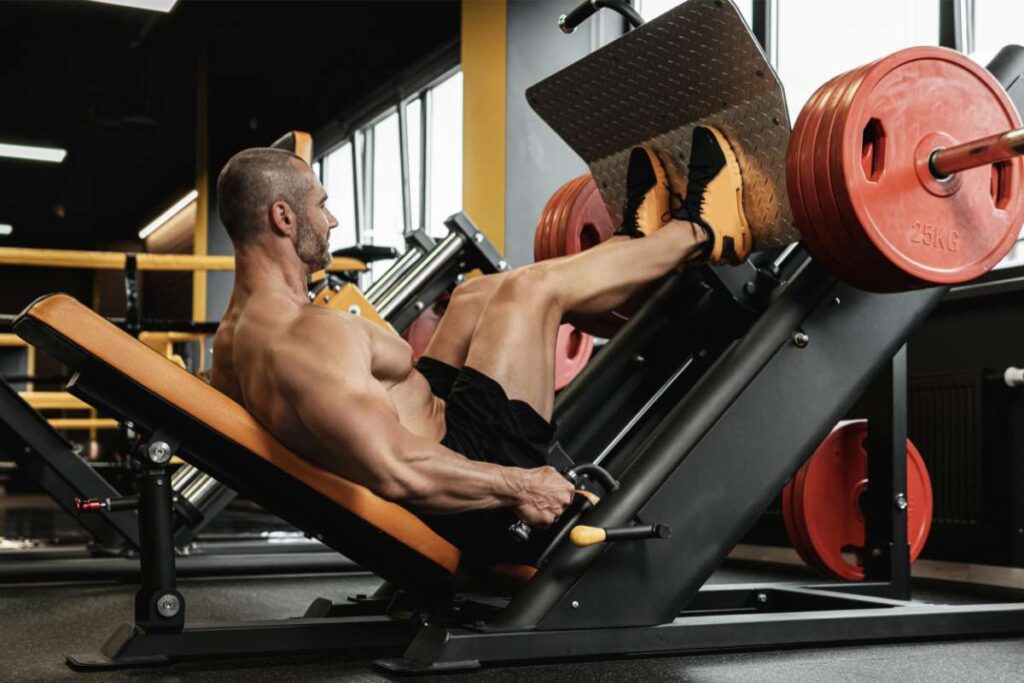
Using the exercises list above, it’s time to create workout plans for both beginner and advanced lifters.
The beginner workout is based on a three-day upper/lower split. There is a rest day between each session and two days off for the weekend.
The advanced workout program is based on a 4 day upper lower split with a rest day mid-week and on the weekends.
This can also extend to a five-day upper lower split should you feel like your training is progressing and want an additional challenge.
Each of the workouts below will be displayed with exercises, sets, reps, rest times, and a weekly schedule to help you kick off into a solid routine.
Beginner Upper/Lower Body Workout Program
Related: What Is The Best 5 Day Workout Split?
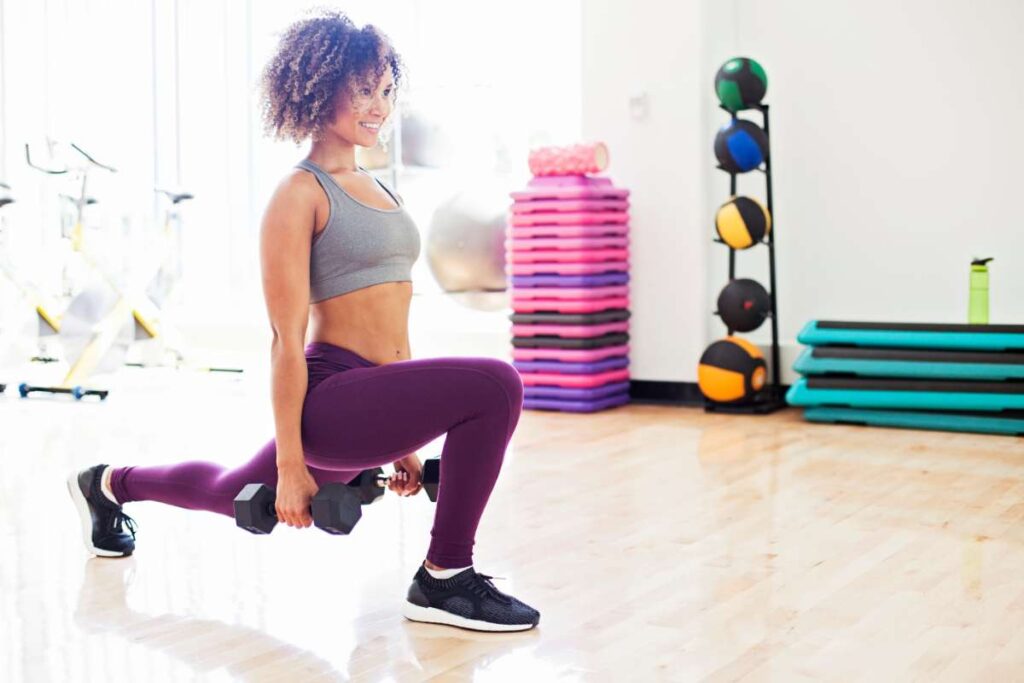
| Mon | Tues | Wed | Thurs | Fri | Sat | Sun |
| Upper | Rest | Lower | Rest | Upper | Rest | Rest |
Upper Body (Duration 35-40 Minutes)
| Exercise | Sets | Reps | Rest |
| Bench Press | 3 | 8-10 | 45-60 secs |
| Dumbbell Incline Press | 3 | 8-10 | 30-45 secs |
| Lat Pulldown | 3 | 8-10 | 30-45 secs |
| Cable Row | 3 | 8-10 | 30-45 secs |
| Dumbbell Overhead Press | 3 | 8-10 | 30-45 secs |
| Barbell Bicep Curls | 3 | 8-10 | 30-45 secs |
Lower Body (Duration 30 Minutes)
| Exercise | Sets | Reps | Rest |
| Barbell Hip Thrust | 3 | 8-12 | 45-60 secs |
| Goblet Squat | 3 | 8-12 | 30-45 secs |
| Dumbbell Walking Lunge | 3 | 10 | 30-45 secs |
| Leg Press | 3 | 10 | 30-45 secs |
| Lying Leg Curl | 3 | 12 | 30-45 secs |
Advanced Upper Lower Body Workout Program

| Mon | Tues | Wed | Thurs | Fri | Sat | Sun |
| Upper | Lower | Rest | Upper | Lower | Rest | Rest |
Upper Body (Duration 55-60 Minutes)
| Exercise | Sets | Reps | Rest |
| Bench Press | 4 | 8 | 45-60 secs |
| Incline Dumbbell Press | 3 | 8-12 | 30-45 secs |
| Deadlift | 4 | 8 | 45-60 secs |
| Pull-Ups | 4 | 8 | 30-45 secs |
| Cable Row | 3 | 8-12 | 30-45 secs |
| Shoulder Press | 3 | 10 | 30-45 secs |
| Dips | 4 | 8 | 30-45 secs |
| Barbell Bicep Curls | 3 | 10-12 | 30-45 secs |
Lower Body (Duration 45-50 Minutes)
| Exercise | Sets | Reps | Rest |
| Barbell Hip Thrust | 3 | 8 | 45-60 secs |
| Back Squat | 4 | 8 | 45-60 secs |
| Dumbbell Walking Lunge | 3 | 8-12 | 45-60 secs |
| Belt Squat | 4 | 8 | 30-45 secs |
| Leg Press | 3 | 10 | 30-45 secs |
| Lying Leg Curl | 3 | 12 | 30-45 secs |
| Goblet Squat | 3 | 15 | 30-45 secs |
Upper/Lower Split Workout Plan PDF
Tips for Doing an Upper/Lower Split Workout Effectively
The upper lower split is a great way to train and build lean muscle. Still, to get the most out of your session, you will need to tackle these areas.
Increase Protein Intake
Protein is an essential part of our diet and vital to building lean muscle mass. It also assists in the recovery of damaged muscle tissue.
Studies recommend a daily intake of 1.6g-2.2g of protein per kilogram when building muscle.
This will ensure that you are giving your body the exact macros it needs to capitalize on your intense upper lower split training routine.
Track Your Nutrition
Correct nutrition is key when it comes to achieving your goals in the gym.
It not only dictates whether we lose weight or gain muscle, but it can also determine how we perform in the gym.
To find out your exact calorie and macronutrient intake, try our calorie and macronutrient calculator.
This will help you determine the calorie intake to match your goals. You also get a precise carbohydrate intake to fuel your session, protein to build muscle, and fat to soak up those essential nutrients.
Stick To Your Plan
Sticking to your plan is one of the most effective ways to ensure that every upper body lower body split workout is a success.
Often, when we are in the thick of our programming and our lifts plateau, it can be easy to get distracted. We want to jump ship in hopes that the grass is greener with another routine.
However, rarely does this help move the needle forward. It just disrupts our routine and our focus.
Sticking to your guns and completing your program will allow you to continue building and consolidating your lifts, and help you to continue building toward your goals.
Progressive Overload
Just like all workouts, it is important to progressively overload to continue building muscle.
Research suggests that progressive overload in the form of incremental increases to sets, reps, and weight is vital to building lean muscle mass.
Doing this each session in accordance with your plan and program will help you take a measured step toward your goal with every session.
Prioritize Rest Day
When you program an upper/lower split workout, your rest days are just as critical as your working ones.
As we learned here, rest days are when our body repairs damaged muscle tissue and becomes stronger, replenishing energy stores and reducing fatigue.
Scheduling these either as a complete rest day or actively, in the form of a walk or recreation activity, can not only improve growth, but help give you mental clarity to continue with your program.
Final Thoughts
The upper and lower body split workout routine is one of the best ways to introduce split training to beginners and add volume for advanced lifters.
At times, it can feel perfectly balanced. You have the ability to target both muscle groups while still getting between two and four rest days per week.
If you are thinking of trying an upper lower workout split, we recommend starting out with a three or four-day split focused on nailing your routine and consistency.
After a month, if you feel like you want to take your training to the next level, add an extra day. This will help you stick with it long-term and maximize your gains.
So, are you interested in trying the upper/lower split workout? Which training split would best suit your goals?
Let us know in the comments.
Is upper lower split effective?
Yes, the upper lower split is effective for building lean muscle and increasing strength. You will be able to stimulate programmed muscle groups multiple times per week while still getting time for rest.
What is a 4 day split workout upper and lower?
The 4-day split workout upper and lower is configured in an upper, lower, rest, upper, and lower fashion. This will help you hit both workouts twice in a week while still getting three weekly rest days.
Is 4 day upper lower split enough?
Yes, the 4-day upper lower split is enough to build lean muscle mass and strength. This comes down to personal preference, but this layout gives you a great balance of workout to rest days that will help you remain consistent.
Is upper lower split workout good for beginners?
Yes, the upper lower split workout is a great way to introduce training splits to beginners. This is further bolstered by the ability to program three days a week, allowing for four rest days to help ease into the new style of programming.

